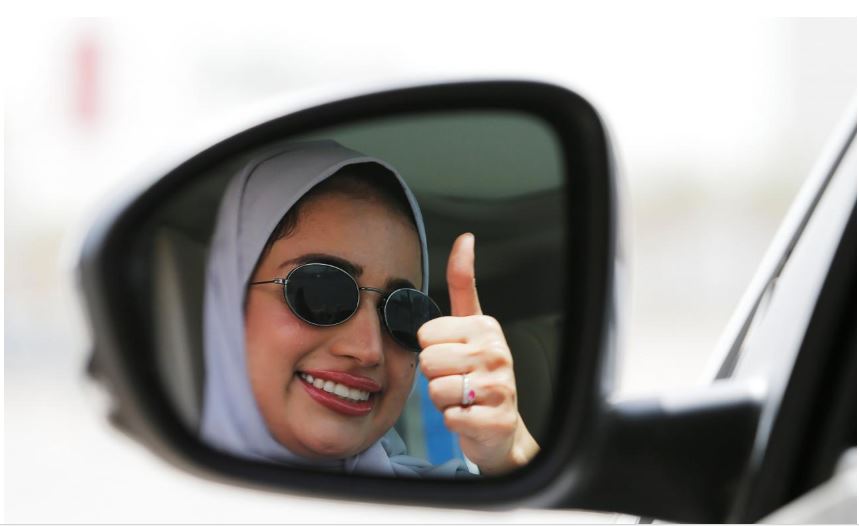 Women in Saudi Arabia took to the roads early on Sunday, ushering in the end of the world’s last ban on female drivers, long seen as an emblem of women’s repression in the deeply conservative Muslim kingdom.
Women in Saudi Arabia took to the roads early on Sunday, ushering in the end of the world’s last ban on female drivers, long seen as an emblem of women’s repression in the deeply conservative Muslim kingdom.
“It’s a beautiful day,” said businesswoman Samah al-Qusaibi as she cruised the eastern city of Khobar just after midnight with police looking on. “Today we are here,” she said from the driver’s seat. “Yesterday we sat there,” she added, pointing to the back.
The ban’s end, ordered last September by King Salman, is part of sweeping reforms pushed by his powerful young son, Crown Prince Mohammed bin Salman, in a bid to transform the economy of the world’s top oil exporter and open up its cloistered society.
“It is our right and finally we took it. It is only a matter of time for the society to accept it, generally,” said Samira al-Ghamdi, a 47-year-old psychologist from Jeddah, as she drove herself to work. She was one of a small group of women who had managed to secure a license beforehand.
The lifting of the prohibition, which for years drew international condemnation and comparisons to the Taliban’s rule in Afghanistan, was welcomed by Western allies as proof of a new progressive trend in Saudi Arabia.
But it has been accompanied by a crackdown on dissent, including against some of the very activists who previously campaigned against it. They now sit in jail as their peers take to the road legally for the first time.
The number of new drivers remains low, as women with foreign permits only began converting them earlier this month. Others are training at new state-run schools, with 3 million women expected to drive by 2020.
Some still face resistance from conservative relatives, and many accustomed to private drivers say they are reluctant to take on the country’s busy highways.
 Women in Saudi Arabia took to the roads early on Sunday, ushering in the end of the world’s last ban on female drivers, long seen as an emblem of women’s repression in the deeply conservative Muslim kingdom.
Women in Saudi Arabia took to the roads early on Sunday, ushering in the end of the world’s last ban on female drivers, long seen as an emblem of women’s repression in the deeply conservative Muslim kingdom.
“It’s a beautiful day,” said businesswoman Samah al-Qusaibi as she cruised the eastern city of Khobar just after midnight with police looking on. “Today we are here,” she said from the driver’s seat. “Yesterday we sat there,” she added, pointing to the back.
The ban’s end, ordered last September by King Salman, is part of sweeping reforms pushed by his powerful young son, Crown Prince Mohammed bin Salman, in a bid to transform the economy of the world’s top oil exporter and open up its cloistered society.
“It is our right and finally we took it. It is only a matter of time for the society to accept it, generally,” said Samira al-Ghamdi, a 47-year-old psychologist from Jeddah, as she drove herself to work. She was one of a small group of women who had managed to secure a license beforehand.
The lifting of the prohibition, which for years drew international condemnation and comparisons to the Taliban’s rule in Afghanistan, was welcomed by Western allies as proof of a new progressive trend in Saudi Arabia.
But it has been accompanied by a crackdown on dissent, including against some of the very activists who previously campaigned against it. They now sit in jail as their peers take to the road legally for the first time.
The number of new drivers remains low, as women with foreign permits only began converting them earlier this month. Others are training at new state-run schools, with 3 million women expected to drive by 2020.
Some still face resistance from conservative relatives, and many accustomed to private drivers say they are reluctant to take on the country’s busy highways.
 Women in Saudi Arabia took to the roads early on Sunday, ushering in the end of the world’s last ban on female drivers, long seen as an emblem of women’s repression in the deeply conservative Muslim kingdom.
Women in Saudi Arabia took to the roads early on Sunday, ushering in the end of the world’s last ban on female drivers, long seen as an emblem of women’s repression in the deeply conservative Muslim kingdom.
“It’s a beautiful day,” said businesswoman Samah al-Qusaibi as she cruised the eastern city of Khobar just after midnight with police looking on. “Today we are here,” she said from the driver’s seat. “Yesterday we sat there,” she added, pointing to the back.
The ban’s end, ordered last September by King Salman, is part of sweeping reforms pushed by his powerful young son, Crown Prince Mohammed bin Salman, in a bid to transform the economy of the world’s top oil exporter and open up its cloistered society.
“It is our right and finally we took it. It is only a matter of time for the society to accept it, generally,” said Samira al-Ghamdi, a 47-year-old psychologist from Jeddah, as she drove herself to work. She was one of a small group of women who had managed to secure a license beforehand.
The lifting of the prohibition, which for years drew international condemnation and comparisons to the Taliban’s rule in Afghanistan, was welcomed by Western allies as proof of a new progressive trend in Saudi Arabia.
But it has been accompanied by a crackdown on dissent, including against some of the very activists who previously campaigned against it. They now sit in jail as their peers take to the road legally for the first time.
The number of new drivers remains low, as women with foreign permits only began converting them earlier this month. Others are training at new state-run schools, with 3 million women expected to drive by 2020.
Some still face resistance from conservative relatives, and many accustomed to private drivers say they are reluctant to take on the country’s busy highways.
 Women in Saudi Arabia took to the roads early on Sunday, ushering in the end of the world’s last ban on female drivers, long seen as an emblem of women’s repression in the deeply conservative Muslim kingdom.
Women in Saudi Arabia took to the roads early on Sunday, ushering in the end of the world’s last ban on female drivers, long seen as an emblem of women’s repression in the deeply conservative Muslim kingdom.
“It’s a beautiful day,” said businesswoman Samah al-Qusaibi as she cruised the eastern city of Khobar just after midnight with police looking on. “Today we are here,” she said from the driver’s seat. “Yesterday we sat there,” she added, pointing to the back.
The ban’s end, ordered last September by King Salman, is part of sweeping reforms pushed by his powerful young son, Crown Prince Mohammed bin Salman, in a bid to transform the economy of the world’s top oil exporter and open up its cloistered society.
“It is our right and finally we took it. It is only a matter of time for the society to accept it, generally,” said Samira al-Ghamdi, a 47-year-old psychologist from Jeddah, as she drove herself to work. She was one of a small group of women who had managed to secure a license beforehand.
The lifting of the prohibition, which for years drew international condemnation and comparisons to the Taliban’s rule in Afghanistan, was welcomed by Western allies as proof of a new progressive trend in Saudi Arabia.
But it has been accompanied by a crackdown on dissent, including against some of the very activists who previously campaigned against it. They now sit in jail as their peers take to the road legally for the first time.
The number of new drivers remains low, as women with foreign permits only began converting them earlier this month. Others are training at new state-run schools, with 3 million women expected to drive by 2020.
Some still face resistance from conservative relatives, and many accustomed to private drivers say they are reluctant to take on the country’s busy highways.
 Women in Saudi Arabia took to the roads early on Sunday, ushering in the end of the world’s last ban on female drivers, long seen as an emblem of women’s repression in the deeply conservative Muslim kingdom.
Women in Saudi Arabia took to the roads early on Sunday, ushering in the end of the world’s last ban on female drivers, long seen as an emblem of women’s repression in the deeply conservative Muslim kingdom.
“It’s a beautiful day,” said businesswoman Samah al-Qusaibi as she cruised the eastern city of Khobar just after midnight with police looking on. “Today we are here,” she said from the driver’s seat. “Yesterday we sat there,” she added, pointing to the back.
The ban’s end, ordered last September by King Salman, is part of sweeping reforms pushed by his powerful young son, Crown Prince Mohammed bin Salman, in a bid to transform the economy of the world’s top oil exporter and open up its cloistered society.
“It is our right and finally we took it. It is only a matter of time for the society to accept it, generally,” said Samira al-Ghamdi, a 47-year-old psychologist from Jeddah, as she drove herself to work. She was one of a small group of women who had managed to secure a license beforehand.
The lifting of the prohibition, which for years drew international condemnation and comparisons to the Taliban’s rule in Afghanistan, was welcomed by Western allies as proof of a new progressive trend in Saudi Arabia.
But it has been accompanied by a crackdown on dissent, including against some of the very activists who previously campaigned against it. They now sit in jail as their peers take to the road legally for the first time.
The number of new drivers remains low, as women with foreign permits only began converting them earlier this month. Others are training at new state-run schools, with 3 million women expected to drive by 2020.
Some still face resistance from conservative relatives, and many accustomed to private drivers say they are reluctant to take on the country’s busy highways.
 Women in Saudi Arabia took to the roads early on Sunday, ushering in the end of the world’s last ban on female drivers, long seen as an emblem of women’s repression in the deeply conservative Muslim kingdom.
Women in Saudi Arabia took to the roads early on Sunday, ushering in the end of the world’s last ban on female drivers, long seen as an emblem of women’s repression in the deeply conservative Muslim kingdom.
“It’s a beautiful day,” said businesswoman Samah al-Qusaibi as she cruised the eastern city of Khobar just after midnight with police looking on. “Today we are here,” she said from the driver’s seat. “Yesterday we sat there,” she added, pointing to the back.
The ban’s end, ordered last September by King Salman, is part of sweeping reforms pushed by his powerful young son, Crown Prince Mohammed bin Salman, in a bid to transform the economy of the world’s top oil exporter and open up its cloistered society.
“It is our right and finally we took it. It is only a matter of time for the society to accept it, generally,” said Samira al-Ghamdi, a 47-year-old psychologist from Jeddah, as she drove herself to work. She was one of a small group of women who had managed to secure a license beforehand.
The lifting of the prohibition, which for years drew international condemnation and comparisons to the Taliban’s rule in Afghanistan, was welcomed by Western allies as proof of a new progressive trend in Saudi Arabia.
But it has been accompanied by a crackdown on dissent, including against some of the very activists who previously campaigned against it. They now sit in jail as their peers take to the road legally for the first time.
The number of new drivers remains low, as women with foreign permits only began converting them earlier this month. Others are training at new state-run schools, with 3 million women expected to drive by 2020.
Some still face resistance from conservative relatives, and many accustomed to private drivers say they are reluctant to take on the country’s busy highways.
 Women in Saudi Arabia took to the roads early on Sunday, ushering in the end of the world’s last ban on female drivers, long seen as an emblem of women’s repression in the deeply conservative Muslim kingdom.
Women in Saudi Arabia took to the roads early on Sunday, ushering in the end of the world’s last ban on female drivers, long seen as an emblem of women’s repression in the deeply conservative Muslim kingdom.
“It’s a beautiful day,” said businesswoman Samah al-Qusaibi as she cruised the eastern city of Khobar just after midnight with police looking on. “Today we are here,” she said from the driver’s seat. “Yesterday we sat there,” she added, pointing to the back.
The ban’s end, ordered last September by King Salman, is part of sweeping reforms pushed by his powerful young son, Crown Prince Mohammed bin Salman, in a bid to transform the economy of the world’s top oil exporter and open up its cloistered society.
“It is our right and finally we took it. It is only a matter of time for the society to accept it, generally,” said Samira al-Ghamdi, a 47-year-old psychologist from Jeddah, as she drove herself to work. She was one of a small group of women who had managed to secure a license beforehand.
The lifting of the prohibition, which for years drew international condemnation and comparisons to the Taliban’s rule in Afghanistan, was welcomed by Western allies as proof of a new progressive trend in Saudi Arabia.
But it has been accompanied by a crackdown on dissent, including against some of the very activists who previously campaigned against it. They now sit in jail as their peers take to the road legally for the first time.
The number of new drivers remains low, as women with foreign permits only began converting them earlier this month. Others are training at new state-run schools, with 3 million women expected to drive by 2020.
Some still face resistance from conservative relatives, and many accustomed to private drivers say they are reluctant to take on the country’s busy highways.
 Women in Saudi Arabia took to the roads early on Sunday, ushering in the end of the world’s last ban on female drivers, long seen as an emblem of women’s repression in the deeply conservative Muslim kingdom.
Women in Saudi Arabia took to the roads early on Sunday, ushering in the end of the world’s last ban on female drivers, long seen as an emblem of women’s repression in the deeply conservative Muslim kingdom.
“It’s a beautiful day,” said businesswoman Samah al-Qusaibi as she cruised the eastern city of Khobar just after midnight with police looking on. “Today we are here,” she said from the driver’s seat. “Yesterday we sat there,” she added, pointing to the back.
The ban’s end, ordered last September by King Salman, is part of sweeping reforms pushed by his powerful young son, Crown Prince Mohammed bin Salman, in a bid to transform the economy of the world’s top oil exporter and open up its cloistered society.
“It is our right and finally we took it. It is only a matter of time for the society to accept it, generally,” said Samira al-Ghamdi, a 47-year-old psychologist from Jeddah, as she drove herself to work. She was one of a small group of women who had managed to secure a license beforehand.
The lifting of the prohibition, which for years drew international condemnation and comparisons to the Taliban’s rule in Afghanistan, was welcomed by Western allies as proof of a new progressive trend in Saudi Arabia.
But it has been accompanied by a crackdown on dissent, including against some of the very activists who previously campaigned against it. They now sit in jail as their peers take to the road legally for the first time.
The number of new drivers remains low, as women with foreign permits only began converting them earlier this month. Others are training at new state-run schools, with 3 million women expected to drive by 2020.
Some still face resistance from conservative relatives, and many accustomed to private drivers say they are reluctant to take on the country’s busy highways.













